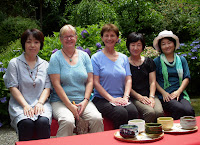Fortune smiled on me this year. The hydrangea brackets were just starting to blush when we took James, Emily, and Kate to Hase-dera early in the month. Two weeks later Meagan My-Knitting-Mentor and I spent a glorious day touring the grounds of Engaku-ji and Meigetsu-in, two temples in Kita (north) Kamakura, with Hiroko, Hisayo, and Kayoko.
Engaku-ji, built in 1282, has expanded over the centuries and now encompasses a whopping 60,000 square meters or nearly 15 acres. (I did the math for you. You are most welcome.)
Along the left side of the grounds is the Butsunichi-an, a subordinate temple built as a mausoleum for Hojo Tokimune, the 6th Shogun of the Kamakura era.
We paid 100 yen each to enter the garden of Ensoku-den, one of three hermitages on the Butsunichi-an property. This garden is famous for two magnolia trees donated in 1931 by a Chinese author, Lu Hsun, when he was a medical student in Japan. What I will remember about that garden, though, is sipping tea out of beautiful pottery bowls with my friends.
To get from Engaku-ji to Meigetsu-in, we strolled down a shady residential lane with throngs of Japanese couples and families. Peeking at the houses and faces along the way was as rewarding as feasting my eyes on a seemingly infinite variety of hydrangeas.
Meigetsu-in was inaugurated in 1160 so it predates Engaku-ji by more than a century. I'm not sure what 'inaugurated' means but that's the word used by the authors of An English Guide to Kamakura's Temples & Shrines. (These are the same authors that tell us Engaku-ji was named for a 'canon' found in a stone arch; I spread this rumor far and wide before it dawned on me they meant to write 'Kannon' instead.)
We had tea at Meigetsu-in as well, this time in paper cups rather than pottery bowls. The setting more than atoned for the scant amenities. We sat on a tatami mat, waiting patiently until it was our turn to step through that round window and perch on a low ledge overlooking a meadow.
To get myself situated on that ledge, I momentarily put my foot on a boulder. There was an interesting bamboo sculpture balanced on the boulder. I silently commended myself for neither breaking it nor knocking it off the rock.
"That bamboo thingamajig is nice," I remarked to Hiroko.
With one of the sweetest smiles in all of Japan, she retorted, "It means 'DO NOT STEP ON THIS ROCK'."
Oops.
 |
| My Knitting Mentor was so appalled by my cultural faux pas that she subsequently fled the country. |






No comments:
Post a Comment